Polar Research
Research Categories | All Research Projects
Our polar research investigates ways to study conditions at the poles, whether through on-site ground instruments or through satellite observations. We look at trends in temperatures and winds, and real-time sea ice conditions for marine transportation. We also develop unique drilling and coring systems to provide ice cores, subglacial rock cores, or sounding holes for the research community at UW and other US institutions.
-
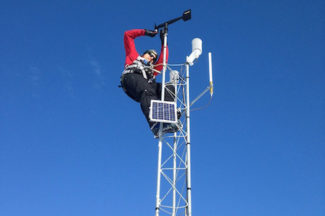
Antarctic Meteorological Research and Data Center (AMRDC)
The Antarctic Meteorological Research and Data Center (AMRDC) is an observational research and data center providing an accessible and reliable method of obtaining Antarctic meteorological data. In addition to establishing a data repository for Antarctic meteorological campaigns and projects, the AMRDC generates and hosts real-time Antarctic meteorological data from throughout the community, including data from the UW-Madison Automatic Weather Station (AWS) Program and Antarctic satellite composite imagery.
Website:
https://amrdc.ssec.wisc.edu/Contact:
Matthew Lazzara (PI), David MikolajczykCategories:
Polar Research, SurfaceSponsors:
NSF -
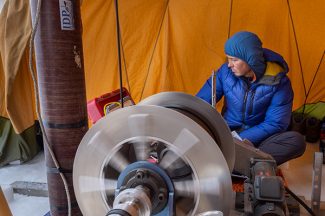
Ice Drilling Program (IDP)
SSEC engineers support the drilling operations of the Ice Drilling Program funded by the National Science Foundation. Our engineers develop, operate, and maintain a variety of drills that are deployed to drill through ice and retrieve ice cores used for research studies.
Website:
https://icedrill.org/Contact:
Kristina SlawnyCategories:
Instruments, Polar ResearchSponsors:
NSF -
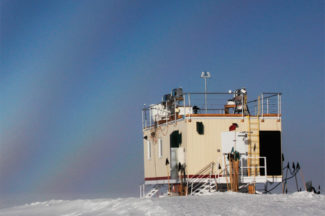
Integrated Characterization of Energy, Clouds, Atmospheric state, and Precipitation at Summit (ICECAPS)
The Integrated Characterization of Energy, Clouds, Atmospheric state, and Precipitation at Summit (ICECAPS) ground-based instrument suite provides cloud, atmosphere, and precipitation measurements at the top of the Greenland Ice Sheet.
Website:
http://icecaps.ssec.wisc.eduContact:
Tristan L’EcyuerCategories:
Clouds, Polar Research -
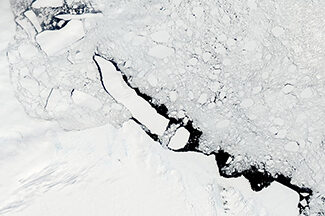
Polar Radiant Energy in the Far Infrared Experiment (PREFIRE)
Led by scientists at CIMSS, PREFIRE is a NASA Cubesat mission designed to take measurements of the Arctic with a specific focus on warming, sea ice loss, ice sheet melt and sea level rise.
Website:
https://prefire.ssec.wisc.edu/Contact:
Tristan L’EcuyerCategories:
Low-Earth Orbiting Satellites, Polar ResearchSponsors:
NASA -
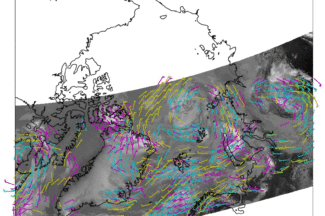
Polar Winds
The Visible Infrared Imaging Radiometer Suite (VIIRS), the MODerate-resolution Imaging Spectroradiometer (MODIS), and the Advanced Very High Resolution Radiometer (AVHRR) are being used to generate high-latitude wind fields by tracking cloud and water vapor features in infrared window and water vapor bands with these applications expanded to LEO-GEO and Sounder based winds.
Contact:
Dave Santek, Rich DworakCategories:
Low-Earth Orbiting Satellites, Polar ResearchSponsors:
NOAA -
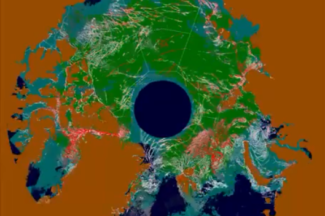
Sea Ice Leads
This project detects and characterizes sea ice leads (fractures in the ice sheet) using data from the polar orbiting Moderate Resolution Imaging Spectroradiometer (MODIS) and the Visible Infrared Imaging Radiometer Suite (VIIRS) instruments.
Website:
https://www.ssec.wisc.edu/leads/Contact:
Jay HoffmanCategories:
Polar Research, SurfaceSponsors:
NASA -
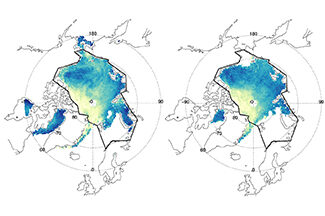
Sea Ice Products
Using satellite data, NOAA and CIMSS scientists are studying sea ice trends in the polar regions.
Contact:
Yinghui Liu, NOAA STAR (PI), Xuanji Wang, Jeff KeyCategories:
Polar Research, SurfaceSponsors:
NOAA -
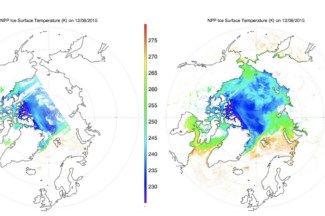
Snow Cover/Ice Surface Temperature
This cryosphere research involves algorithm development to identify ice and snow cover and estimate ice concentration and ice surface temperature over water surfaces using information from satellite observations and other products.
Contact:
Yinghui Liu, NOAA STAR (PI), Xuanji Wang, Jeff KeyCategories:
Polar Research, SurfaceSponsors:
NOAA
